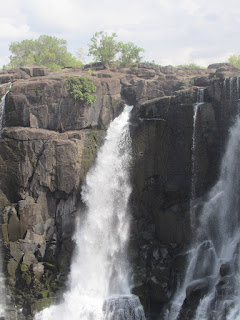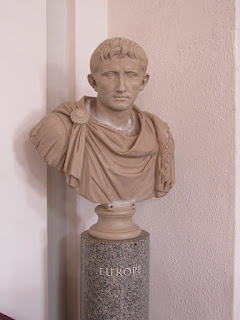 As we walked across a long bridge into Zambia, we could hear loud sounds of water splashing and crashing. On a bridge, we could see the Zambezi River swirling below and several rocky zig-zag gorges. This remarkable place is known for its history, size, geology, and beauty--and we were going to see it firsthand.
As we walked across a long bridge into Zambia, we could hear loud sounds of water splashing and crashing. On a bridge, we could see the Zambezi River swirling below and several rocky zig-zag gorges. This remarkable place is known for its history, size, geology, and beauty--and we were going to see it firsthand.
The indigenous people called the waterfall Mosi-oa-Tunya ("the smoke that thunders"). Dr. David Livingstone, a Scottish missionary, physician and explorer, gave it its present name when he "discovered" it in 1855 during his travels from the upper Zambezi to the mouth of the river between 1852 and 1856. Livingstone aptly wrote of the falls:
"No one can imagine the beauty of the view from anything witnessed in England. It had never been seen before by European eyes; but scenes so lovely must have been gazed upon by angels in their flight."
It isn't hard to imagine Livingstone's surprise when he saw what would one day become one of the seven natural wonders of the world as well as a UNESCO World Heritage Site.

The source of the falls is the Zambezi River, Africa's fourth largest, which begins in Angola in the western part of the continent and crosses eastward through eight countries to empty into the Indian Ocean in Mozambique.
The Victoria Fall Bridge connects two of those countries: Zambia and Zimbabwe. It is 131 feet long and 4.3 feet wide. Below is the road and walkway on the bridge as it enters Zambia. The tourist trade has afforded people have the option of bungee jumping at 364 feet off the bridge or walking below the road and over the arch of the bridge. Neither of those activities appealed to any of us on the safari.
The Victoria Falls Bridge was part of John Cecil Rhodes' (1853-1902) dream to construct a railway line to transport goods, newly discovered mineral deposits, and passengers from Cape Town, South Africa, to Cairo, Egypt. Rhodes was a British diamond mining magnate (he established DeBeers Diamond in 1888) and a South African politician. Although the railway was never completed, the dream to provide east-west access through the southern part of Africa was partially realized with this bridge in 1968.
The bridge was designed and assembled in sections at the Cleveland Bridge and Engineering factory yard in Darlington, UK, before being shipped to Africa. Its main arch spans over 500 feet and it is 420 feet above the river surface. It was constructed in 14 months between 1904-1905 at a cost of 72,000 pounds (11 million pounds today) or almost US$14 million.
The main arc of the bridge was joined on April 1, 1905. The two center girders of the arc were in place by March 31 but they overlapped by 1.25 inches. When work resumed at sunrise the next morning, it was found that the bridge had contracted by exactly 1.25 inches. The two center girders had dropped into place and fitted perfectly! The bridge was officially opened on September 12, 1905 by Professor George Darwin, grandson of Sir Charles Darwin.
Victoria Falls Bridge is currently the only rail link between Zambia and Zimbabwe, and a leopard was the first creature to cross the bridge upon its completion.

Paved pathways and a small pedestrian bridge were built along the length of the falls in order to see its different sections at different angles on both the Zambian side and the Zimbabwean side. In certain sections of the trail we were "baptized" by the Victoria Falls.
This photo of the falls show the zig-zag gorges the river follows. The falls had previously occupied these U-shaped gorges thanks to uplifts over the past 2 millions years. Volcanic activities that occurred 200 million years ago also shaped the geology of the area. The current waterfall is its 10th gorge and starting to create its 11th drop. The falls present the largest curtain of naturally falling water in the world.
The falls' gorge is over a mile long and its rock wall is 354 feet at its highest point. It was declared a national monument in 1959 based on evidence of human habitation and interaction with the falls area during the Stone Age. Its water spray is visible 18 to 31 miles away.
Since the mid 20th century, the falls has been an increasingly important source of tourism revenue. Among the offerings for visitors is a helicopter ride. Simone Jarrett, one of my Australian friends (left) went with her South African friend, Ida, for a ride to enjoy the view from above and took these three "snaps".


I've visited some great waterfalls including Niagara (NY, Canada), Yellowstone (WY), Tahquamenon (MI), and now Victoria. Each one is dynamic in its own way.

 This is a
statue of Dr. David Livingstone, a Scottish missionary and the first-known
white man to have sighted the Falls on November 18, 1855. It stands in the national parks on both the Zambian side and the Zimbabwean side.
This is a
statue of Dr. David Livingstone, a Scottish missionary and the first-known
white man to have sighted the Falls on November 18, 1855. It stands in the national parks on both the Zambian side and the Zimbabwean side. He named the "Victoria Falls" after the then-Queen of England. He first came to Africa in 1841 and made three explorations in Africa lasting a total of 33 years. The statue was erected in 2005 to commemorate 150 years of his sighting the Falls.
Livingstone died in Zambia in 1873. His internal body parts were buried in a Chitambo village, Serenje District in the Central province of Zambia while his body was embalmed, preserved with salt, and carried to the coast by his workers for transportation to Britain. It took nine months for his remains to reach Britain, and he was finally buried on April 18, 1874.
Livingstone is one of the few revered white Europeans in Africa. He helped the native people rather than dominate them. He was a missionary, but he never converted anyone. And, he fought against the slave trade that was secretly going on in Zanzibar and contributed to its abolition.

During the rainy season, the falls cover the walls of the gorge. We were there during the end of the dry season so there were a lot of streams just dribbling.
Home Visit
 Charles is getting ready to take his final exams in high school. He will then go on to college.
Charles is getting ready to take his final exams in high school. He will then go on to college.  Martin, Jr., is in high school and he
likes soccer. Judging from his knees, he is a pretty good player.
Martin, Jr., is in high school and he
likes soccer. Judging from his knees, he is a pretty good player.
 Martin has driven a cab and now he drives a truck. Grace recently started her own catering business. In her kitchen you could see some pretty big cooking pots. Martin and their sons help Grace when they can.
Martin has driven a cab and now he drives a truck. Grace recently started her own catering business. In her kitchen you could see some pretty big cooking pots. Martin and their sons help Grace when they can.
We spent some time in conversation over drinks before dinner. Then the cooking began with a little bit of our help.


Grace had us try our hand
at stirring the rice for our meal. Tina (blue top) turned out to be the
best one for the task because of her Chinese background. Stefani and I worked hard at getting the job done despite our lack of technique.

Grace demonstrated the traditional Zimbabwean way to prepare for the meal: on her knees, she pours water for her husband and then serves him his meal. However, this couple is modern, and I don't think this is what they regularly do.
We all helped ourselves to a delicious meal of chicken, rice, beans, greens, and carrots with African spices.
Victoria Falls Hotel
On our second trip to Victoria Falls, Zimbabwe, the last three days of our trip, we had some time to look around. A few of us walked to the Victoria Falls Hotel, an historic luxury hotel.
The hotel was opened in 1904 to accommodate passengers on the newly built line on National Railways of Zimbabwe, part of Cecil Rhodes' plan for a Cape to Cairo Railway. Later the hotel served as a staging post for the BOAC flying boat service between Southampton and South Africa.
The hotel has been the site of many important political meetings like the creation of the Federation of Rhodesia and Nyasaland in 1949 and the 1963 Victoria Falls Conference that led to the breakup of that federation. In 1975, another Victoria Falls Conference tried to sort out Rhodesia's Unilateral Declaration of Independence that followed the break-up of the Federation.

Main corridors and simple but elaborate stairways and entrance ways

The hotel tended to attract
special guests like Princess Christian of Schleswig-Holstein and her
daughter, Princess Helena Victoria in September 1904, and King George VI
and his family (with the future Queen Elizabeth) in April 1947. So it made things look and feel comfortably royal.

A sitting room with accompanying classical busts and royal paintings

Two of the four statues representing the four continents -- all in Roman togas!


The gardens with a flagpole marking the miles between Cairo and Cape Town for the proposed railway between the two African cities
The garden terrace provides a dramatic view of the Victoria Falls Bridge, which straddles the Second Gorge.
The Victoria Falls Hotel would be a wonderful place to stay, however, the minimal cost for a room with two single beds was 699 Euros. Not in my budget!
Zambezi River Cruise
Mist from Victoria Falls

Hippos in the river and a crocrodile guarding her nest on shore

Members of our safari enjoy the evening river cruise before we say good-bye to MC, our trip leader, and each other.

The last sunset of our safari of two glorious weeks
Good-bye Zimbabwe
MC had a special treat for us as we said good-bye after breakfast on our last day. First, we listened to a lecture about Dr. John Livingstone from a retired guide. Then MC walked us over to the other side of the hotel to listen to this group who sang with some pretty spectacular harmony.
Sources
The National Heritage Conservation Commission of Zambia












































No comments:
Post a Comment